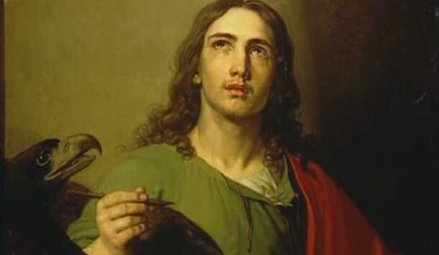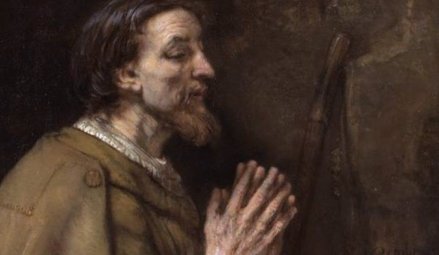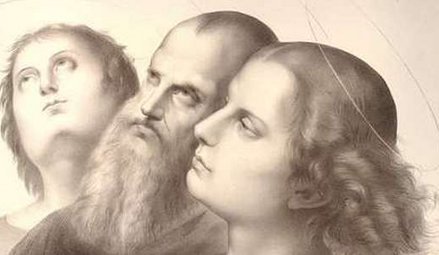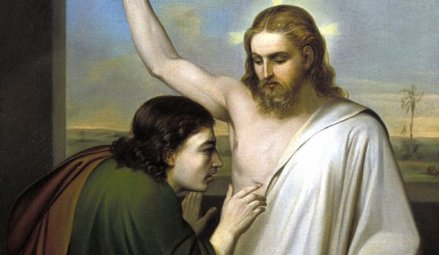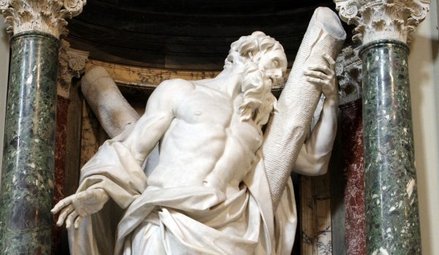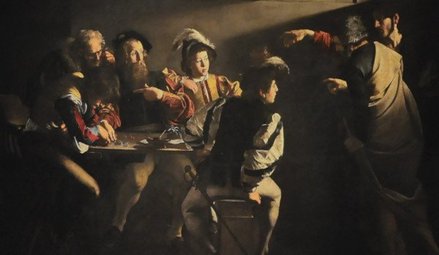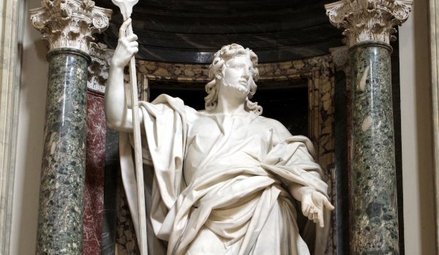- By theme
- Jesus
- The many proofs of Christ’s resurrection
- Saint Thomas Aquinas: God gave all the divine proofs we needed to believe
- The surpassing power of Christ's word
- Lewis’s trilemma: a proof of Jesus’s divinity
- God saves: the power of the holy name of Jesus
- Jesus spoke and acted as God's equal
- Jesus' divinity is actually implied in the Koran
- Jesus came at the perfect time of history
- Rabbinical sources testify to Jesus' miracles
- Mary
- The Church
- The Bible
- An enduring prophecy and a series of miraculous events preventing the reconstruction of the Temple
- The authors of the Gospels were either eyewitnesses or close contacts of those eyewitnesses
- Onomastics support the historical reliability of the Gospels
- The New Testament was not altered
- The New Testament is the best-attested manuscript of Antiquity
- The Gospels were written too early after the facts to be legends
- Archaeological finds confirm the reliability of the New Testament
- The criterion of embarrassment proves that the Gospels tell the truth
- The dissimilarity criterion strengthens the case for the historical reliability of the Gospels
- 84 details in Acts verified by historical and archaeological sources
- The unique prophecies that announced the Messiah
- The time of the coming of the Messiah was accurately prophesied
- The prophet Isaiah's ultra accurate description of the Messiah's sufferings
- Daniel's "Son of Man" is a portrait of Christ
- The Apostles
- Saint Peter, prince of the apostles
- Saint John the Apostle: an Evangelist and Theologian who deserves to be better known (d. 100)
- Saint Matthew, apostle, evangelist and martyr (d. 61)
- James the Just, “brother” of the Lord, apostle and martyr (d. 62 AD)
- Saint Matthias replaces Judas as an apostle (d. 63)
- The martyrs
- The protomartyr Saint Stephen (d. 31)
- Polycarp, bishop of Smyrna, disciple of John and martyr (d. 155)
- Justin Martyr: philosopher and apologist (d.165)
- Saint Blandina and the Martyrs of Lyon: the fortitude of faith (177 AD)
- Saint Agatha stops a volcano from destroying the city of Catania (d. 251)
- Saint Lucy of Syracuse, virgin and martyr for Christ (d. 304)
- Saint Boniface propagates Christianity in Germany (d. 754)
- Thomas More: “The king’s good servant, but God’s first”
- The martyrdom of Paul Miki and his companions (d. 1597)
- The martyrs of Angers and Avrillé (1794)
- The Martyrs of Compiègne (1794)
- The Vietnamese martyrs Father Andrew Dung-Lac and his 116 companions (17th-19th centuries)
- He braved torture to atone for his apostasy (d. 1818)
- Blaise Marmoiton: the epic journey of a missionary to New Caledonia (d. 1847)
- The Uganda martyrs: a recurring pattern in the persecution of Christians (1885)
- José Luis Sanchez del Rio, martyred at age 14 for Christ the King (d. 1928)
- Saint Maximilian Kolbe, Knight of the Immaculate (d. 1941)
- The monks
- The Desert Fathers (3rd century)
- Saint Anthony of the Desert, a father of monasticism (d. 356)
- Saint Benedict, father of Western monasticism (d. 550)
- Saint Bruno the Carthusian (d.1101): the miracle of a hidden life
- Blessed Angelo Agostini Mazzinghi: the Carmelite with flowers pouring from his mouth (d. 1438)
- Monk Abel of Valaam's accurate prophecies about Russia (d. 1841)
- The more than 33,000 miracles of Saint Charbel Maklouf (d. 1898)
- Saint Pio of Pietrelcina (d. 1968): How God worked wonders through "a poor brother who prays"
- The surprising death of Father Emmanuel de Floris (d. 1992)
- The prophecies of Saint Paisios of Mount Athos (d. 1994)
- The saints
- Saints Anne and Joachim, parents of the Virgin Mary (19 BC)
- Saint Nazarius, apostle and martyr (d. 68 or 70)
- Ignatius of Antioch: successor of the apostles and witness to the Gospel (d. 117)
- Saint Gregory the Miracle-Worker (d. 270)
- Saint Martin of Tours: patron saint of France, father of monasticism in Gaul, and the first great leader of Western monasticism (d. 397)
- Saint Augustine of Canterbury evangelises England (d. 604)
- Saint Lupus, the bishop who saved his city from the Huns (d. 623)
- Saint Rainerius of Pisa: from musician to merchant to saint (d. 1160)
- Saint Dominic of Guzman (d.1221): an athlete of the faith
- Saint Francis, the poor man of Assisi (d. 1226)
- Saint Anthony of Padua: "everyone’s saint"
- Saint Rose of Viterbo or How prayer can transform the world (d. 1252)
- Saint Simon Stock receives the scapular of Mount Carmel from the hands of the Virgin Mary
- The unusual boat of Saint Basil of Ryazan
- Saint Agnes of Montepulciano's complete God-confidence (d. 1317)
- The extraordinary conversion of Michelina of Pesaro
- Saint Peter Thomas (d. 1366): a steadfast trust in the Virgin Mary
- Saint Rita of Cascia: hoping against all hope
- Saint Catherine of Genoa and the Fire of God's love (d. 1510)
- Saint Anthony Mary Zaccaria, physician of bodies and souls (d. 1539)
- Saint Ignatius of Loyola (d. 1556): "For the greater glory of God"
- Brother Alphonsus Rodríguez, SJ: the "holy porter" (d. 1617)
- Martin de Porres returns to speed up his beatification (d. 1639)
- Virginia Centurione Bracelli: When God is the only goal, all difficulties are overcome (d.1651)
- Saint Marie of the Incarnation, "the Teresa of New France" (d.1672)
- St. Francis di Girolamo's gift of reading hearts and souls (d. 1716)
- Rosa Venerini: moving in the ocean of the Will of God (d. 1728)
- Saint Jeanne-Antide Thouret: heroic perseverance and courage (d. 1826)
- Seraphim of Sarov (1759-1833): the purpose of the Christian life is to acquire the Holy Spirit
- Camille de Soyécourt, filled with divine fortitude (d. 1849)
- Bernadette Soubirous, the shepherdess who saw the Virgin Mary (1858)
- Saint John Vianney (d. 1859): the global fame of a humble village priest
- Gabriel of Our Lady of Sorrows, the "Gardener of the Blessed Virgin" (d. 1862)
- Father Gerin, the holy priest of Grenoble (1863)
- Blessed Francisco Palau y Quer: a lover of the Church (d. 1872)
- Saints Louis and Zelie Martin, the parents of Saint Therese of Lisieux (d. 1894 and 1877)
- The supernatural maturity of Francisco Marto, “contemplative consoler of God” (d. 1919)
- Saint Faustina, apostle of the Divine Mercy (d. 1938)
- Brother Marcel Van (d.19659): a "star has risen in the East"
- Doctors
- The mystics
- Lutgardis of Tongeren and the devotion to the Sacred Heart
- Saint Angela of Foligno (d. 1309) and "Lady Poverty"
- Saint John of the Cross: mystic, reformer, poet, and universal psychologist (+1591)
- Blessed Anne of Jesus: a Carmelite nun with mystical gifts (d.1621)
- Catherine Daniélou: a mystical bride of Christ in Brittany
- Saint Margaret Mary sees the "Heart that so loved mankind"
- Jesus makes Maria Droste zu Vischering the messenger of his Divine Heart (d. 1899)
- Mother Yvonne-Aimée of Jesus' predictions concerning the Second World War (1922)
- Sister Josefa Menendez, apostle of divine mercy (d. 1923)
- Edith Royer (d. 1924) and the Sacred Heart Basilica of Montmartre
- Rozalia Celak, a mystic with a very special mission (d. 1944)
- Visionaries
- Saint Perpetua delivers her brother from Purgatory (203)
- María de Jesús de Ágreda, abbess and friend of the King of Spain
- Discovery of the Virgin Mary's house in Ephesus (1891)
- Sister Benigna Consolata: the "Little Secretary of Merciful Love" (d. 1916)
- Maria Valtorta's visions match data from the Israel Meteorological Service (1943)
- Berthe Petit's prophecies about the two world wars (d. 1943)
- Maria Valtorta saw only one pyramid at Giza in her visions... and she was right! (1944)
- The location of Saint Peter's village seen in a vision before its archaeological discovery (1945)
- The 700 extraordinary visions of the Gospel received by Maria Valtorta (d. 1961)
- The amazing geological accuracy of Maria Valtorta's writings (d. 1961)
- Maria Valtorta's astronomic observations consistent with her dating system
- Discovery of an ancient princely house in Jerusalem, previously revealed to a mystic (d. 1961)
- Mariette Kerbage, the seer of Aleppo (1982)
- The 20,000 icons of Mariette Kerbage (2002)
- The popes
- The great witnesses of the faith
- Saint Augustine's conversion: "Why not this very hour make an end to my uncleanness?" (386)
- Thomas Cajetan (d. 1534): a life in service of the truth
- Madame Acarie, "the servant of the servants of God" (d. 1618)
- Blaise Pascal (d.1662): Biblical prophecies are evidence
- Madame Élisabeth and the sweet smell of virtue (d. 1794)
- Jacinta, 10, offers her suffering to save souls from hell (d. 1920)
- Father Jean-Édouard Lamy: "another Curé of Ars" (d. 1931)
- Christian civilisation
- The depth of Christian spirituality
- John of the Cross' Path to perfect union with God based on his own experience
- The dogma of the Trinity: an increasingly better understood truth
- The incoherent arguments against Christianity
- The "New Pentecost": modern day, spectacular outpouring of the Holy Spirit
- The Christian faith explains the diversity of religions
- Cardinal Pierre de Bérulle (d.1629) on the mystery of the Incarnation
- Christ's interventions in history
- Marian apparitions and interventions
- The Life-giving Font of Constantinople
- Apparition of Our Lady of La Treille in northern France: prophecy and healings (600)
- Our Lady of Virtues saves the city of Rennes in Bretagne (1357)
- Mary stops the plague epidemic at Mount Berico (1426)
- Our Lady of Miracles heals a paralytic in Saronno (1460)
- Cotignac: the first apparitions of the Modern Era (1519)
- Savona: supernatural origin of the devotion to Our Lady of Mercy (1536)
- The Virgin Mary delivers besieged Christians in Cusco, Peru
- The victory of Lepanto and the feast of Our Lady of the Rosary (1571)
- The apparitions to Brother Fiacre (1637)
- The “aldermen's vow”, or the Marian devotion of the people of Lyon (1643)
- Our Lady of Nazareth in Plancoët, Brittany (1644)
- Our Lady of Laghet (1652)
- Saint Joseph’s apparitions in Cotignac, France (1660)
- Heaven confides in a shepherdess of Le Laus (1664-1718)
- Zeitoun, a two-year miracle (1968-1970)
- The Holy Name of Mary and the major victory of Vienna (1683)
- Heaven and earth meet in Colombia: the Las Lajas shrine (1754)
- The five Marian apparitions that traced an "M" over France, and its new pilgrimage route
- A series of Marian apparitions and prophetic messages in Ukraine since the 19th century (1806)
- "Consecrate your parish to the Immaculate Heart of Mary" (1836)
- At La Salette, Mary wept in front of the shepherds (1846)
- Our Lady of Champion, Wisconsin: the first and only approved apparition of Mary in the US (1859)
- Gietrzwald apparitions: heavenly help to a persecuted minority
- The silent apparition of Knock Mhuire in Ireland (1879)
- Mary "Abandoned Mother" appears in a working-class district of Lyon, France (1882)
- The thirty-three apparitions of the Virgin Mary in Beauraing (1932)
- "Our Lady of the Poor" appears eight times in Banneux (1933)
- Fontanelle-Montichiari apparitions of Our Lady "Rosa Mystica" (1947)
- Mary responds to the Vows of the Polish Nation (1956)
- Zeitoun apparitions
- The Virgin Mary comes to France's rescue by appearing at L'Ile Bouchard (1947)
- Maria Esperanza Bianchini and Mary, Mary, Reconciler of Peoples and Nations (1976)
- Luz Amparo and the El Escorial apparitions
- The extraordinary apparitions of Medjugorje and their worldwide impact
- The Virgin Mary prophesied the 1994 Rwandan genocide (1981)
- Our Lady of Soufanieh's apparition and messages to Myrna Nazzour (1982)
- The Virgin Mary heals a teenager, then appears to him dozens of times (1986)
- Seuca, Romania: apparitions and pleas of the Virgin Mary, "Queen of Light" (1995)
- Angels and their manifestations
- Mont Saint-Michel: Heaven watching over France
- The revelation of the hymn Axion Estin by the Archangel Gabriel (982)
- Angels give a supernatural belt to the chaste Thomas Aquinas (1243)
- The constant presence of demons and angels in the life of St Frances of Rome (d. 1440)
- Mother Yvonne-Aimée escapes from prison with the help of an angel (1943)
- Saved by Angels: The Miracle on Highway 6 (2008)
- Exorcisms in the name of Christ
- A wave of charity unique in the world
- Saint Peter Nolasco: a life dedicated to ransoming enslaved Christians (d. 1245)
- Rita of Cascia forgives her husband's murderer (1404)
- Saint Angela Merici: Christ came to serve, not to be served (d. 1540)
- Saint John of God: a life dedicated to the care of the poor, sick and those with mental disorders (d. 1550)
- Saint Camillus de Lellis, reformer of hospital care (c. 1560)
- Blessed Alix Le Clerc, encouraged by the Virgin Mary to found schools (d. 1622)
- Saint Vincent de Paul (d. 1660), apostle of charity
- Marguerite Bourgeoys, Montreal's first teacher (d. 1700)
- Frédéric Ozanam, inventor of the Church's social doctrine (d. 1853)
- Damian of Molokai: a leper for Christ (d. 1889)
- Pier Giorgio Frassati (d.1925): heroic charity
- Saint Dulce of the Poor, the Good Angel of Bahia (d. 1992)
- Mother Teresa of Calcutta (d. 1997): an unshakeable faith
- Heidi Baker: Bringing God's love to the poor and forgotten of the world
- Amazing miracles
- The miracle of liquefaction of the blood of St. Januarius (d. 431)
- The miracles of Saint Anthony of Padua (d. 1231)
- Saint Pius V and the miracle of the Crucifix (1565)
- Saint Philip Neri calls a teenager back to life (1583)
- The resurrection of Jérôme Genin (1623)
- Saint Francis de Sales brings back to life a victim of drowning (1623)
- Saint John Bosco and the promise kept beyond the grave (1839)
- The day the sun danced at Fatima (1917)
- Pius XII and the miracle of the sun at the Vatican (1950)
- When Blessed Charles de Foucauld saved a young carpenter named Charle (2016)
- Reinhard Bonnke: 89 million conversions (d. 2019)
- Miraculous cures
- The royal touch: the divine thaumaturgic gift granted to French and English monarchs (11th-19th centuries)
- With 7,500 cases of unexplained cures, Lourdes is unique in the world (1858-today)
- Our Lady at Pellevoisin: "I am all merciful" (1876)
- Mariam, the "little thing of Jesus": a saint from East to West (d.1878)
- The miraculous healing of Marie Bailly and the conversion of Dr. Alexis Carrel (1902)
- Gemma Galgani: healed to atone for sinners' faults (d. 1903)
- The miraculous cure of Blessed Maria Giuseppina Catanea
- The extraordinary healing of Alice Benlian in the Church of the Holy Cross in Damascus (1983)
- The approved miracle for the canonization of Juan Diego Cuauhtlatoatzin (1990)
- Healed by St Charbel Makhlouf, her scars bleed each month for the benefit of unbelievers (1993)
- The miracle that led to Brother André's canonisation (1999)
- Bruce Van Natta's intestinal regrowth: an irrefutable miracle (2007)
- He had “zero” chance of living: a baby's miraculous recovery (2015)
- Manouchak, operated on by Saint Charbel (2016)
- How Maya was cured from cancer at Saint Charbel's tomb (2018)
- Preserved bodies of the saints
- Dying in the odour of sanctity
- The body of Saint Cecilia found incorrupt (d. 230)
- Saint Claudius of Besançon: a quiet leader, a calm presence, and a strong belief in the value of prayer (d. 699)
- Stanislaus Kostka's burning love for God (d. 1568)
- Saint Germaine of Pibrac: God's little Cinderella (d. 1601)
- Blessed Antonio Franco, bishop and defender of the poor (d. 1626)
- Giuseppina Faro, servant of God and of the poor (d. 1871)
- The incorrupt body of Marie-Louise Nerbollier, the visionary from Diémoz (d. 1910)
- The great exhumation of Saint Charbel (1950)
- Bilocations
- Inedias
- Levitations
- Lacrimations and miraculous images
- Saint Juan Diego's tilma (1531)
- The Rue du Bac apparitions of the Virgin Mary to St. Catherine Labouré (Paris, 1830)
- Mary weeps in Syracuse (1953)
- Teresa Musco (d.1976): salvation through the Cross
- Soufanieh: A flow of oil from an image of the Virgin Mary, and oozing of oil from the face and hands of Myrna Nazzour (1982)
- The Saidnaya icon exudes a wonderful fragrance (1988)
- Our Lady weeps in a bishop's hands (1995)
- Stigmates
- The venerable Lukarda of Oberweimar shares her spiritual riches with her convent (d. 1309)
- Florida Cevoli: a heart engraved with the cross (d. 1767)
- Blessed Maria Grazia Tarallo, mystic and stigmatist (d. 1912)
- Saint Padre Pio: crucified by Love (1918)
- Elena Aiello: "a Eucharistic soul"
- A Holy Triduum with a Syrian mystic, witnessing the sufferings of Christ (1987)
- A Holy Thursday in Soufanieh (2004)
- Eucharistic miracles
- Lanciano: the first and possibly the greatest Eucharistic miracle (750)
- A host came to her: 11-year-old Imelda received Communion and died in ecstasy (1333)
- Faverney's hosts miraculously saved from fire
- A tsunami recedes before the Blessed Sacrament (1906)
- Buenos Aires miraculous host sent to forensic lab, found to be heart muscle (1996)
- Relics
- The Veil of Veronica, known as the Manoppello Image
- For centuries, the Shroud of Turin was the only negative image in the world
- The Holy Tunic of Argenteuil's fascinating history
- Saint Louis (d. 1270) and the relics of the Passion
- The miraculous rescue of the Shroud of Turin (1997)
- A comparative study of the blood present in Christ's relics
- Jews discover the Messiah
- Francis Xavier Samson Libermann, Jewish convert to Catholicism (1824)
- Our Lady of the Miraculous Medal and the conversion of Alphonse Ratisbonne (1842)
- Max Jacob: a liberal gay Jewish artist converts to Catholicism (1909)
- Edith Stein - Saint Benedicta of the Cross: "A daughter of Israel who, during the Nazi persecutions, remained united with faith and love to the Crucified Lord, Jesus Christ, as a Catholic, and to her people as a Jew"
- Patrick Elcabache: a Jew discovers the Messiah after his mother is miraculously cured in the name of Jesus
- Olivier's conversion story: from Pesach to the Christian Easter (2000)
- Cardinal Aron Jean-Marie Lustiger (d. 2007): Chosen by God
- Muslim conversions
- He met Jesus while looking for Muhammad (1990)
- Selma's journey to baptism (1996)
- Soumia, converted to Jesus as she hears Christmas carols (2003)
- How Aïsha, a Muslim convert, found Jesus (2004)
- Amir chooses Christ, at the risk of becoming homeless (2004)
- Souad Brahimi: brought to Jesus by Mary (2012)
- Pursued by God: Khadija's story (2023)
- Buddhist conversions
- Atheist conversions
- The conversion of an executioner during the Terror (1830)
- God woos a poet's heart: the story of Paul Claudel's conversion (1886)
- From agnostic to Catholic Trappist monk (1909)
- Dazzled by God: Madeleine Delbrêl's story (1924)
- C.S. Lewis, the reluctant convert (1931)
- The day André Frossard met Christ in Paris (1935)
- MC Solaar's rapper converts after experiencing Jesus' pains on the cross
- Father Sébastien Brière, converted at Medjugorje (2003)
- Franca Sozzani, the "Pope of fashion" who wanted to meet the Pope (2016)
- Nelly Gillant: from Reiki Master to Disciple of Christ (2018)
- Testimonies of encounters with Christ
- Near-death experiences (NDEs) confirm Catholic doctrine on the Four Last Things
- The NDE of Saint Christina the Astonishing, a source of conversion to Christ (1170)
- Jesus audibly calls Alphonsus Liguori to follow him (1723)
- Blessed Dina Bélanger (d. 1929): loving God and letting Jesus and Mary do their job
- Gabrielle Bossis: He and I
- André Levet's conversion in prison
- Journey between heaven and hell: a "near-death experience" (1971)
- Jesus' message to Myrna Nazzour (1984)
- Alicja Lenczewska: conversations with Jesus (1985)
- Vassula Ryden and the "True Life in God" (1985)
- Nahed Mahmoud Metwalli: from persecutor to persecuted (1987)
- The Bible verse that converted a young Algerian named Elie (2000)
- Invited to the celestial court: the story of Chantal (2017)
- Providential stories
- The superhuman intuition of Saint Pachomius the Great
- Ambrose of Milan finds the bodies of the martyrs Gervasius and Protasius (386)
- Germanus of Auxerre's prophecy about Saint Genevieve's future mission, and protection of the young woman (446)
- Seven golden stars reveal the future location of the Grande Chartreuse Monastery (1132)
- The supernatural reconciliation of the Duke of Aquitaine (1134)
- Saint Zita and the miracle of the cloak (13th c.)
- Joan of Arc: "the most beautiful story in the world"
- John of Capistrano saves the Church and Europe (1456)
- A celestial music comforts Elisabetta Picenardi on her deathbed (d. 1468)
- Gury of Kazan: freed from his prison by a "great light" (1520)
- The strange adventure of Yves Nicolazic (1623)
- Julien Maunoir miraculously learns Breton (1626)
- Pierre de Keriolet: with Mary, one cannot be lost (1636)
- How Korea evangelized itself (18th century)
- A hundred years before it happened, Saint Andrew Bobola predicted that Poland would be back on the map (1819)
- The prophetic poem about John Paul II (1840)
- Don Bosco's angel dog: Grigio (1854)
- The purifying flames of Sophie-Thérèse de Soubiran La Louvière (1861)
- Thérèse of Lisieux saved countless soldiers during the Great War
- Lost for over a century, a Russian icon reappears (1930)
- In 1947, a rosary crusade liberated Austria from the Soviets (1946-1955)
- The discovery of the tomb of Saint Peter in Rome (1949)
- He should have died of hypothermia in Soviet jails (1972)
- God protects a secret agent (1975)
- Flowing lava stops at church doors (1977)
- A protective hand saved John Paul II and led to happy consequences (1981)
- Mary Undoer of Knots: Pope Francis' gift to the world (1986)
- Edmond Fricoteaux's providential discovery of the statue of Our Lady of France (1988)
- The Virgin Mary frees a Vietnamese bishop from prison (1988)
- The miracles of Saint Juliana of Nicomedia (1994)
- Global launch of "Pilgrim Virgins" was made possible by God's Providence (1996)
- The providential finding of the Mary of Nazareth International Center's future site (2000)
- Syrian Monastery shielded from danger multiple times (2011-2020)
- Jesus
- Who are we?
- Make a donation
TOUTES LES RAISONS DE CROIRE
Les Apôtres
n°52
Palestine and Rome (Italy)
1st century
Saint Peter, prince of the apostles
Peter, originally named Simon, was a disciple and apostle of Jesus. Jesus invested him with his authority, so that he could continue his work here on earth, together with the other disciples. Saint Peter's rank and authority among the twelve apostles, and that of his successors at the head of the Catholic Church, have biblical, historical and archaeological bases.
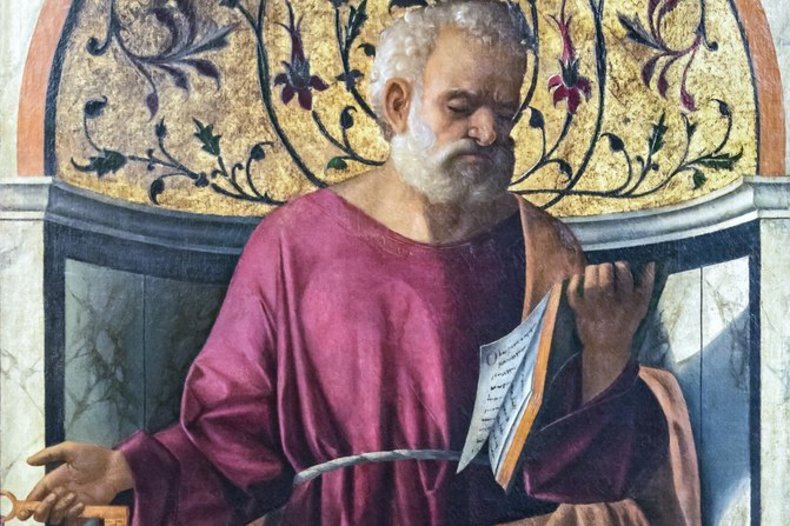
Saint Pierre par Giovanni Bellini, vers 1487, Gallerie dell'Accademia, Venise / ©CC0/wikimedia
Les raisons d'y croire :
- Peter was involved in every episode of Jesus' life right up to his crucifixion, and played an important role in it: he was the first to proclaim Jesus' messiahship and the truth of the Christian faith after he left the Upper Room at Pentecost; Jesus chose him to come and join him by walking on the water (Mt 14:27-29); he witnessed the miraculous catch of fish (Mt 4:18-22 ; Jn 21:1-11), the calming of the storm (Mk 4:35-41), the raising of Jairus' daughter (Mt 9:18-26), the multiplication of the loaves (Mt 14:13-21), the Transfiguration (Mt 17:16-18), the announcement of the Passion (Mt 20:17-19; Lk 18:31-34), etc.
- After the Passion, the biblical writings definitively show Peter's primary place in the nascent Church: he is the first witness to the Resurrection (Lk 24:12) and the only apostle entrusted by Christ with the mission of "shepherding" Christians. Peter also played a key role in the election of the apostle Matthias.
- Far from being an after-the-fact addition or an apocryphal invention, Jesus' words establishing Peter's primacy ("You are Peter, and on this rock I will build my Church", Mt 16:18) are authentic. Linguists and exegetes have noted a perfect coherence between the narrative construction, syntax, terminology and use of metaphorical terms of this passage and the Aramaic language of first-century Palestinians.
- In the four lists of the twelve apostles in the New Testament, Peter is always mentioned first. The four Gospels mention St. Peter 120 times, compared with 81 for the other eleven apostles, a clear indication of the pre-eminence accorded him by the early Christian community.
- Peter is neither an intellectual ("uneducated and ordinary", Acts 4:13) nor a political leader: he becomes leader of the apostles, not because of his natural abilities, but solely by decision of Christ. This is the meaning of the formula pronounced by Jesus when he first meets Peter ("You are Simon, the son of John; you shall be called Cephas", Jn 1:42). A change of name had an important significance in biblical times: the patronymic reveals the spiritual function of its bearer. Therefore Simon Peter was receiving a new vocation.
- Numerous historical sources attest to Peter's stay in Rome, where he became head of the city's Christian community.
- Archaeological excavations undertaken since 1945 attest to the presence of that apostle's tomb beneath St. Peter's Basilica in the Vatican, and to the veneration he has received since the 1st century.
Synthèse :
Peter's original name was Symeon (Acts 15:14; 2 Pt 1:1), translated into Greek as "Simon". Matthew's Gospel refers to him as "Simon called Peter" (Mt 4:18; Mk 1:16-18), who was the brother of Andrew. Both were the first men chosen by Jesus to become his disciples.
Born in the early years of the 1st century A.D., Simon was the son of Jona (Johannes) and was born in Bethsaida, a town on Lake Tiberias (Lake of Gennesaret, also known as the Sea of Galilee). He lived and worked as a fisherman in Capernaum (Mk 1:29), also on the shore of the lake, and was a married man (the evangelists describe Jesus' healing of Peter's mother-in-law). Tradition attributes to him a daughter named Petronilla.
Peter was a simple man, "uneducated and ordinary" (Acts 4:13). He became leader of the apostles, not because of his natural abilities, but by decision of Christ alone. This is the meaning of the words spoken by Jesus when he first met Peter: "You are Simon, the son of John; you shall be called Cephas" (Jn 1:42). "Cephas" in Aramaic is generally translated as "Rock" in Greek (Petros) and in Latin (Petrus). Such a name change has an important significance in biblical culture. Since the patronymic reveals the spiritual function of its bearer, Simon Peter had just received a new vocation.
Peter was one of the five disciples who witnessed Jesus' first miracle at the wedding feast in Cana. After that first public miracle, these men confessed their faith in Jesus for the first time (Jn 2:11). From then on, Peter was to take part in every episode of Jesus' life, right up to his crucifixion: the miraculous catch of fish (Mt 4:18-22; Jn 21:1-11), during which Peter casts his nets because he believes in Jesus' word; the choice of the twelve apostles, where Peter is named first (Mt 10:2 ; Lk 6:12-16); the calming of the storm (Mk 4:35-41); the raising of Jairus' daughter (Mt 9:18-26); the multiplication of the loaves (Mt 14:13-21); the Transfiguration (Mt 17:16-18); the announcement of the Passion (Mt 20:17-19; Lk 18:31-34), etc.
Then, at Jesus' request, Peter takes part with John in the preparation of the Passover in Jerusalem (Mt 26:17-19; Mk 14:12-16). Peter is also present at the washing of the feet, during which he expresses his bafflement when Jesus comes up to him (Jn 13:6-9). And, of course, he is present at the Last Supper (Mt 26:26-29). Even before the prophecy of his denial, Peter's primacy is perfectly recalled in Lk 22:31-32: "I have prayed that your own faith may not fail; and once you have turned back, you must strengthen your brothers."
The four evangelists unanimously quote Jesus' prophecy of Peter's future triple denial: Nowhere else in the Bible does Christ refer so precisely to the human weakness of the chief apostle, not to accuse him, but to show that his choice was not based on human criteria, but on love:"As I have loved you, so you also should love one another. This is how all will know that you are my disciples, if you have love for one another." (Jn 13: 35).
Throughout history, reservations have been voiced about Peter's primacy: how could a man who denied his Master three times, and who was absent from Golgotha, have been the head of the apostles? In reality, the entire content of the New Testament after the Passion unequivocally shows Peter's first place in the nascent Church: he is the first witness to the Resurrection (Lk 24:12) and the only apostle entrusted by Christ with the mission of "feeding his sheep, i.e of "shepherding" Christians.
This pastoral task was in no way entrusted to him in the manner of a personal position of authority which, however great, would have disappeared at his death. Jesus created an actual, ongoing "ministry": He invested Peter with his authority to carry on his work on earth in union with the other disciples, as shown in the famous passage where Christ confers on him the spiritual mission of guiding his brothers in the faith after the apostle has confessed Jesus' messiahship: "You are Peter, and on this rock I will build my Church" (Mt 16:18).
This passage has been extensively commented on. All the ancient versions of the Gospel of St. Matthew that we have at our disposal contain these phrases in identical form. What's more, nowhere else in the Gospels is there a passage so characteristic of Aramaic language and culture: linguists and exegetes have noted a perfect consistency between the narrative construction, syntax, terminology, metaphorical terms of the quoted passage and the language of first-century Palestinians. Moreover, biblical references play an essential role here: the "rock Kephas" refers to the book of Isaiah: "See, I am laying a stone in Zion, a stone that has been tested, a precious cornerstone as a sure foundation; whoever puts faith in it will not waver" (Is 28:16); the verbs "bind" and "loose" ("to open" or "to close" a person's access to a community, hence the idea of the "keys" held by the head of the apostles), widely used in Judaism at the time, symbolize the power conferred on Peter, and echo Is 22:22:"I will place the key of the house of David on his shoulder." The argument for a later addition is thus definitively eliminated.
The New Testament never ceases to illustrate Peter's eminent place, and right after the Ascension, he is mentioned first among the apostles gathered in the "upper room" (Acts 1:13). To list all the episodes in which Peter plays a key role in the first Christian community would take us through the whole book of the Acts of the Apostles: Peter was the first to speak and add Matthias to the eleven apostles (Acts 1:15-22); he was the first to confess his faith in Christ after leaving the upper room on the day of Pentecost (Acts 2:14-36); he was the first (and only) to invite the "men of Judea" to convert (Acts 2:38-39); the first, along with John, to perform miracles of healing (Acts 3:1-10); the only apostle to give a public speech at "Solomon's Portico" (Acts 3:12-26); he was taken by force to the Sanhedrin with John (Acts 4:1-7), where he delivered not a defense but a confession of faith (Acts 4:9-14); he rebuked Simon the Magician and pronounced a judgment against Sapphira and Ananias (Acts 5:1-11); he laid his hands on the Samaritans (Acts 8:17); raised Aeneas from the dead (Acts 9:32-35) and then Tabitha (Acts 9:36-43); and he spoke of "Jesus Christ, Lord of all men" to the pagan centurion Cornelius (Acts 10:34-43). It is significant to note that St. Paul's mission did not begin until after the conversion of this Roman centurion.
The most quoted figure after Jesus in the canonical Gospels, Peter spoke publicly in Jerusalem to address some objections (Acts 11:1-18), and he was miraculously freed from prison by an angel (Acts 12:7-11). At the Jerusalem assembly attended by all the apostles, he took the floor with authority to draw the theological conclusions of Cornelius' conversion: the gift of the Holy Spirit, forgiveness of sins, and salvation - all gifts offered by Jesus to the Gentiles - and resolved an important question (Acts 15:5-21).
Then, between the years 41 and 44, Peter went to Rome, probably landing at Ostia, where Emperor Claudius had built a new port. Some have cast doubt about Peter's Roman residency, lasting until his martyrdom, however, we now know with certainty that the prince of the apostles did live in Rome, as numerous and varied historical sources attest.
First and foremost, archaeological findings have corroborated Saint Peter's presence in Rome and his primacy. The excavations undertaken beneath St. Peter's Basilica from 1939 onwards led to the discovery of several tombs dating from around 130 located and excavated under the "Chapel of the Confession", a monument later built over the tomb of the prince of the apostles. One of them, covered with tiles, bears the seal of Emperor Vespasian, whose reign lasted from 69 to 79, a date extremely close to that of Peter's martyrdom.
Between 320 and 327, Constantine built a five-aisled basilica atop the early Christian necropolis that was purported to be Peter's resting place. Much of the Vatican Hill was leveled to provide a firm foundation for the first St. Peter's Basilica, dedicated in 350. The altar of the Basilica was planned to be located directly over the tomb. The matter was complicated by the upper chamber or memoria above the vault. This upper chamber had become precious to the Christians of Rome during times of persecution, and they were unwilling that it should be destroyed. The memoria (built by Pope Anicet around 200) was turned into the Chapel of the Confession. Above that was the main floor of the Basilica, with the raised altar directly over the Chapel of the Confession.
In 1939, archaeological excavation of the pagan mausoleum complex under the foundations of St. Peter's Basilica (the Vatican Necropolis), dating to the 2nd and 3rd centuries, found an abnormally located wall with a small niched monument built ca. 160. No mausoleum had ever been built directly beneath the present high altar of St Peter's, which did however contain shallow burials, one dated by an impressed tile to the reign of Vespasian (time of Peter’s martyrdom).
A funerary urn was also unearthed in 1942, containing bones. The anthropological tests on the relics suggested that the bone fragments belong to a man who was a 1st-century, 60–70 years old robust male - very close in age to Peter.
But why did this emperor choose this location rather than another? Indeed, the building's location is very complicated: halfway up the Vatican hill, the basilica required incredible earthworks and even the destruction of numerous ancient tombs.
The historical continuity of the upkeep and renovation of the tomb is fully proven, at the highest level of the Church: Pope Pelagius II at the end of the 6th century, Saint Gregory the Great in the 7th, Leo IV around 850 (etc.), all made the site a well-known center of pilgrimage.
The discovery of Peter's relics was announced by St. Paul VI on June 26, 1968, then at Christmas 1973 by Professor Philippo Maggi, director of archaeological research at the Vatican, then a third time by the Pope on June 29, 1976.
Likewise, written documents attest to Peter's presence and death in Rome. As early as 95, Pope St. Clement, St. Peter's third successor, spoke of St. Peter's martyrdom in a letter to the Christians of Corinth.
At the very beginning of the 2nd century, Saint Ignatius of Antioch wrote of the Church of Rome that it "presides in the chief place of the Roman territory." Around 142, the Shepherd of Hermas (a Christian literary work of the late first half of the second century, considered a valuable book by many Christians, and considered canonical scripture by some of the early Church fathers such as Irenaeus) asserts that Rome, the place of Peter's martyrdom, is a privileged place among Christian communities worldwide.
In the last years of the 2nd century, we have a growing number of sources: the Commentary on the Sentences of the Lord by Papias, bishop of Hierapolis (d. 140), attests to Peter's presence in the Eternal City and explains that the evangelist Mark summarized the teaching of the prince of the apostles in this city; his testimony is all the more remarkable given that Papias knew direct disciples of the apostles. Letters from bishop Denys of Corinth and later from St. Irenaeus of Lyons (the latter showing around 180 that heresies exist simply because their followers disagree with the Church of Rome: "It is with this Church [...], because of its high pre-eminence, that the whole Church must agree", Against Heresies III, 3: 1-2), clearly prove that at this date, the Roman Church, initially led by Peter and then by his successors, enjoyed an unquestionable precedence.
Around 235, in an effort to demonstrate the apostolic origins of Rome's Christians, Pope Liberius' Liberian Catalogue lists all the popes from the time of St. Peter, without interruption.
In the 4th century, Eusebius of Caesarea (d. 339) dates Peter's arrival in the capital of the Roman Empire to 42, and fixes his martyrdom in 67, on Vatican Hill, during Nero's persecution. Before his death in 397, St. Ambrose of Milan wrote: "Where Peter is, there is the Church." By this time, the Roman see was already a sign of the Christian unity desired by Jesus. Since the second half of the 4th century, Peter and Paul have been part of the Church's liturgy. After several emperors - from Aurelian to Constantine - had considered the bishop of Rome to be the cement of the unity of the baptized, Pope Damasus (d. 387) truly transformed the Roman episcopate into the papacy. It was this pope who was the first to promulgate a decretal, i.e. a manual of rules addressed by him to the churches of Gaul who had asked him to do so.
From this point on, the primacy of St. Peter was constantly emphasized. Pope Innocent (d. 417) put forward the idea that the Western Churches were instituted exclusively by bishops consecrated by St. Peter or his direct successors. In 519, the Patriarch of Constantinople John II, the Byzantine Emperor Justin I and all the bishops promulgated the following words: "We wish to follow in all things the communion of the Apostolic See [Rome], where the full and true solidity of the Christian faith resides."
Half a century earlier, the pontificate of Leo the Great had seen the appearance of the title "Supreme Pontiff" to designate the bishop of Rome, successor of Peter: in his homilies, this pope spoke of the "Roman primacy".
Patrick Sbalchiero
Au-delà des raisons d'y croire :
Peter was chosen by Jesus as a model Christian, apostle and martyr. He was involved in every action of Jesus' ministry and, after Pentecost, was a principal contributor to the spread of the Christian faith. His presence and death in Rome made the city's episcopal see a sign of the unity of the apostles and all Christians, just as Christ had wished. This is the teaching of the Catechism of the Catholic Church (1992) and of the Second Vatican Council (1962-1965), as well as that of the twenty previous councils in history: "The Lord made Simon alone, whom he named Peter, the "rock" of his Church. He gave him the keys of his Church and instituted him shepherd of the whole flock. ‘The office of binding and loosing which was given to Peter was also assigned to the college of apostles united to its head.’ This pastoral office of Peter and the other apostles belongs to the Church's very foundation and is continued by the bishops under the primacy of the Pope."(CCC § 881). Peter is "the perpetual and visible principle and foundation of unity"(Lumen gentium 23); in this capacity, his successor "has full, supreme and universal power over the Church." (Lumen gentium 22) and the college of bishops has authority only on condition that it is united with him. (Lumen gentium 22).
Aller plus loin :
Stephen K. Ray, Upon This Rock: St. Peter and the Primacy of Rome in Scripture and the Early Church (Modern Apologetics Library) – March 16, 1999
En savoir plus :- Article The Primacy of Peter by James Akin
- Video by Catholic Answers, What is the evidence for papal primacy?
20 Answers: The Papacy by Jim Blackburn
Pope Fiction: Answers to 30 Myths and Misconceptions About the Papacy by Patrick Madrid
Jesus, Peter, and the Keys: A Scriptural Handbook on the Papacy by Scott Butler, Norman Dahlgren, and David Hess
Upon This Rock: St. Peter and the Primacy of Rome in Scripture and the Early Church by Stephen K. Ray
Studies on the Early Papacy by Dom John Chapman
- The Papacy: What the Pope Does and Why It Matters by Steve Ray and Dennis Walters
- Pope Peter by Joe Heschmeyer
- Pope Fiction: Answers to 30 Myths and Misconceptions About the Papacy by Patrick Madrid
- The Papacy: Revisiting the Debate Between Catholics and Orthodox by Erick Ybarra
20 Answers: The Papacy by Jim Blackburn
Pope Fiction: Answers to 30 Myths and Misconceptions About the Papacy by Patrick Madrid
Jesus, Peter, and the Keys: A Scriptural Handbook on the Papacy by Scott Butler, Norman Dahlgren, and David Hess
Upon This Rock: St. Peter and the Primacy of Rome in Scripture and the Early Church by Stephen K. Ray
Studies on the Early Papacy by Dom John Chapman










